As America’s students accumulate debt, the resumption of loan payments reignites debate over potential bailouts.
Tens of millions of Americans will start receiving their monthly federal student loan bills again, the first time in three years, as the pause on loan payments and collections expired on Oct. 1.
The pause first went into effect in March 2020 as part of the Trump administration’s effort to ease the financial burden on Americans as the government enacted stay-at-home orders during the COVID-19 pandemic. The repayment pause was extended numerous times under the Trump and Biden administrations but ended on Oct. 1 after a debt-ceiling deal prohibited President Joe Biden from extending it further.
For most borrowers, the first payment will be due in October, but not everyone will have the same due date.
Borrowers will receive a bill at least 21 days before payment is due, noting the payment amount and due date, according to the Department of Education (DOE), which oversees a federal student loan portfolio totaling more than $1.6 trillion, owed by about 43 million people.
Those who graduate in the spring don’t have to make payments until their grace period expires, which is typically six to nine months after they leave school.
Borrowers can expect the monthly repayment to be the same as it was before the pause—unless they made optional repayments or changes to their account, such as consolidating loans—as their repayment amounts were essentially frozen.
Interest on federal student loans was resumed at the beginning of September after rates were effectively set to zero in March 2020. Borrowers can expect to pay the same interest rates that they paid before the freeze.
Repayment Plans
Typically, borrowers will pay back their loans through income-driven repayment (IDR) plans, in which the monthly repayment amount is primarily based on the borrower’s income, and any remaining balance will be discharged at the end of the 20- or 25-year repayment term.
The DOE currently offers four different IDR plans. Its newest, “most affordable” IDR plan, dubbed Saving on A Valuable Education (SAVE), is replacing the widely used Revised Pay As You Earn plan, known as REPAYE. The department is also limiting new enrollments in other older repayment plans.
By Bill Pan






